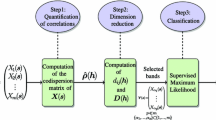Abstract
A landscape approach to ecological land mapping, as illustrated in this article, proceeds by pattern recognition based on ecological theory. The unit areas delineated are hypotheses that arise from a knowledge of what is ecologically important in the land. Units formed by the mapper are likely to be inefficient or irrelevant for ecological purposes unless he possesses a sound rationale as to the interactions and controlling influences of the structural components of ecosystems. Here is the central problem with what have been called “objective” multivariate approaches to mapping based on grid units and the sometimes arbitrary attributes thereof; they tend to conceal the importance of ecological theory and the necessity for theory-based supervision of pattern recognition. Multivariate techniques are best used iteratively to verify and refine map units initially recognized and delineated by theoretical considerations. These ideas are illustrated by an example of a reconnaissance survey in the Northwest Territories of Canada.
Similar content being viewed by others
Literature cited
Bradley, S. W., J. S. Rowe, and C. Tarnocai. 1981. Ecological Land Classification Studies: The Lockhart River Map Area (N.T.S. 75), Western Subarctic of the N.W.T. Lands Directorate, Environment Canada, Ottawa, ON, Canada. (In press).
Brush, S. G. 1974. Should the history of science be rated X?Science 183:1164–1172.
Bryson, R. A. 1966. Air masses, streamlines, and the boreal forest.Geographical Bulletin 8:228–269.
Bunce, R. G. H., S. K. Morell, and H. E. Stel. 1975. The application of multivariate analysis to regional survey.Journal of Environmental Management 3:151–166.
Buse, A. 1974. Habitats as recording units in ecological survey: A field trial in Caernarvonshire, North Wales.Journal of Applied Ecology 12:517–528.
Christian, C. S., and G. A. Stewart. 1968. Methodology of Integrated Survey: Aerial Surveys and Integrated Studies, UNESCO, Paris.
Goodall, D. W. 1953. Objective methods for the classification of vegetation. I. The use of positive interspecific correlation.Australian Journal of Botany 1:39–63.
Hare, F. K., and J. C. Ritchie. 1972. The boreal bioclimates.Geographical Review 62:333–365.
Hills, G. A. 1960. Regional site research.Forestry Chronicle 36:401–423.
Johnson, E. A., and J. S. Rowe. 1975. Fire in the subarctic wintering ground of the Beverley caribou herd.Amer. Midland Natur. 94:1–14.
Kellogg, C. E. 1958. A look at future soil problems. First North American Forest Soils Conference Proceedings, East Lansing. Bulletin Agriculture Experimental Station, Michigan State University, pp. 1–5.
Kessell, S. R. 1979. Phytosociological inference and resource management.Environmental Management 3:29–40.
Kuhn, T. S. 1970. The Structure of Scientific Revolutions. University of Chicago Press, Chicago, IL. 2nd ed. 210 pp.
Lacate, D. S. 1969. Guidelines for Bio-Physical Land Classification. Publication No. 1264, Canadian Forestry Service, Ottawa, ON, Canada. 61 pp.
Mabbutt, J. A. 1968. Review of concepts of land classification. Pages 11–28in G. A. Stewart, ed. Land Evaluation. Macmillan, Melbourne, Australia.
Macfadyen, A. 1975. Some thoughts on the behaviour of ecologists.J. Ecology 63:379–391.
MacHattie, L. B., and R. J. McCormack. 1961. Forest microclimate: A topographic study in Ontario.J Ecol. 49:301–323.
Nie, H. H., C. H. Hull, J. C. Jenkins, K. Steinbrenner, and D. H. Bent. 1975. Statistical Package for the Social Sciences. McGraw-Hill, Toronto, ON, Canada. 675 pp.
Pfister, R. D., and S. F. Arno. 1980. Classifying forest habitat types based on potential climax vegetation.Forest Sci. 26:52–70.
Robinove, C. J. 1979. Integrated Terrain Mapping with Digital LANDSAT Images in Queensland, Australia. Geological Survey Professional Paper 1102, Geological Survey, Washington, DC. 39 pp.
Rowe, J. S. 1961. The level-of-integration concept and ecology.Ecology 42:420–427.
—, 1980. The common denominator of land classification in Canada: an ecological approach to mapping.For. Chron. 56:19–20.
Rubec, C. D. A. 1979. Applications of Ecological (Biophysical) Land Classification in Canada. Ecological Land Classification Series No. 7. Lands Directorate, Environment Canada, Ottawa, ON, Canada. 396 pp.
Sneath, P. H. A., and R. R. Sokal. 1973. Numerical Taxonomy. W. H. Freeman, San Francisco, CA. 573 pp.
Speight, J. G. 1977. Landform pattern description from aerial photographs.Photogrammetria 32:161–182.
Stocker, M., F. F. Gilbert, and D. W. Smith. 1977. Vegetation and deer habitat relations in southern Ontario: Classification of habitat types.J Applied Ecol. 14:419–432.
Williams, W. T. 1967. Numbers, taxonomy and judgment.Bot. Rev. 33:378–386.
Author information
Authors and Affiliations
Rights and permissions
About this article
Cite this article
Rowe, J.S., Sheard, J.W. Ecological land classification: A survey approach. Environmental Management 5, 451–464 (1981). https://doi.org/10.1007/BF01866822
Issue Date:
DOI: https://doi.org/10.1007/BF01866822



